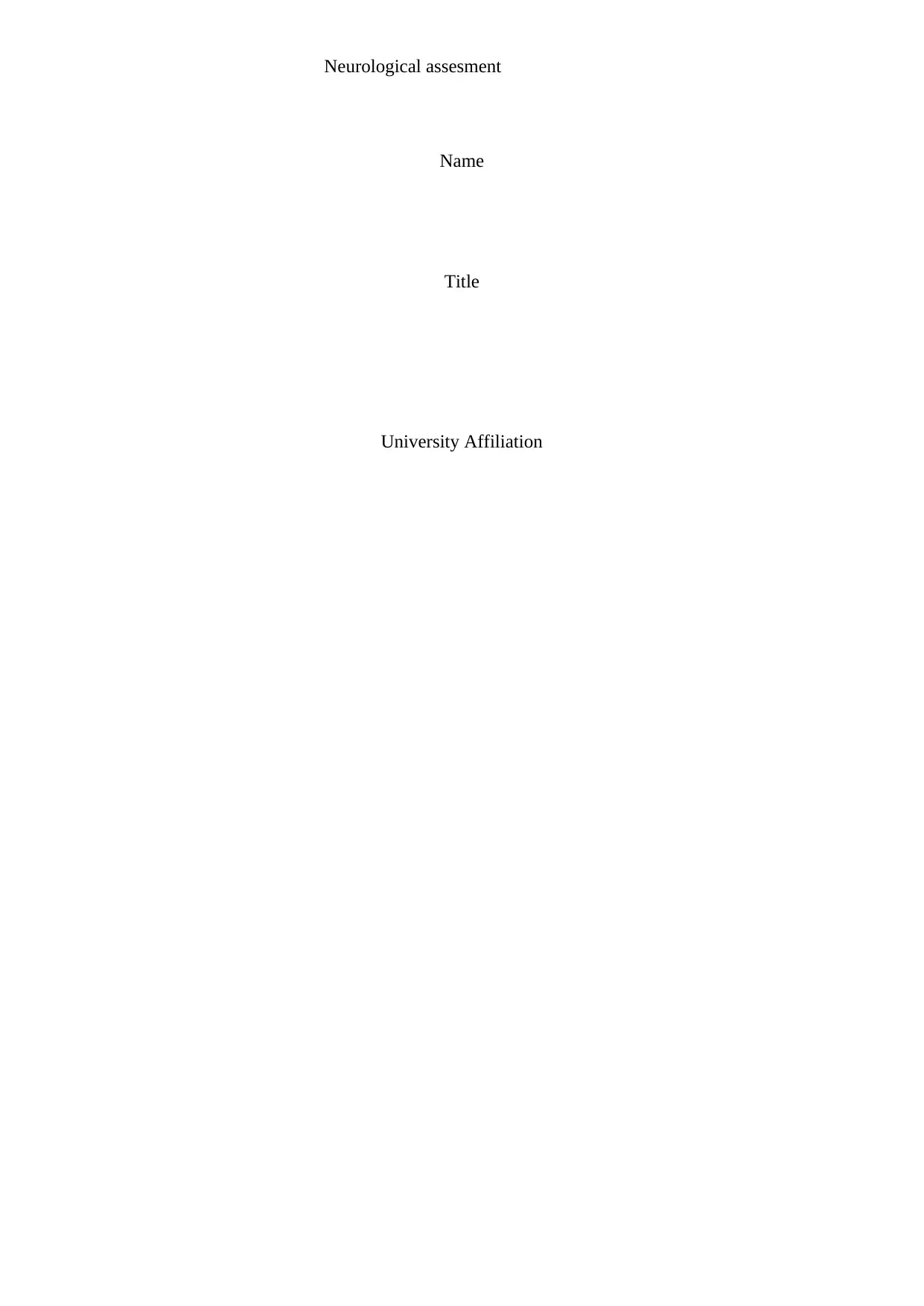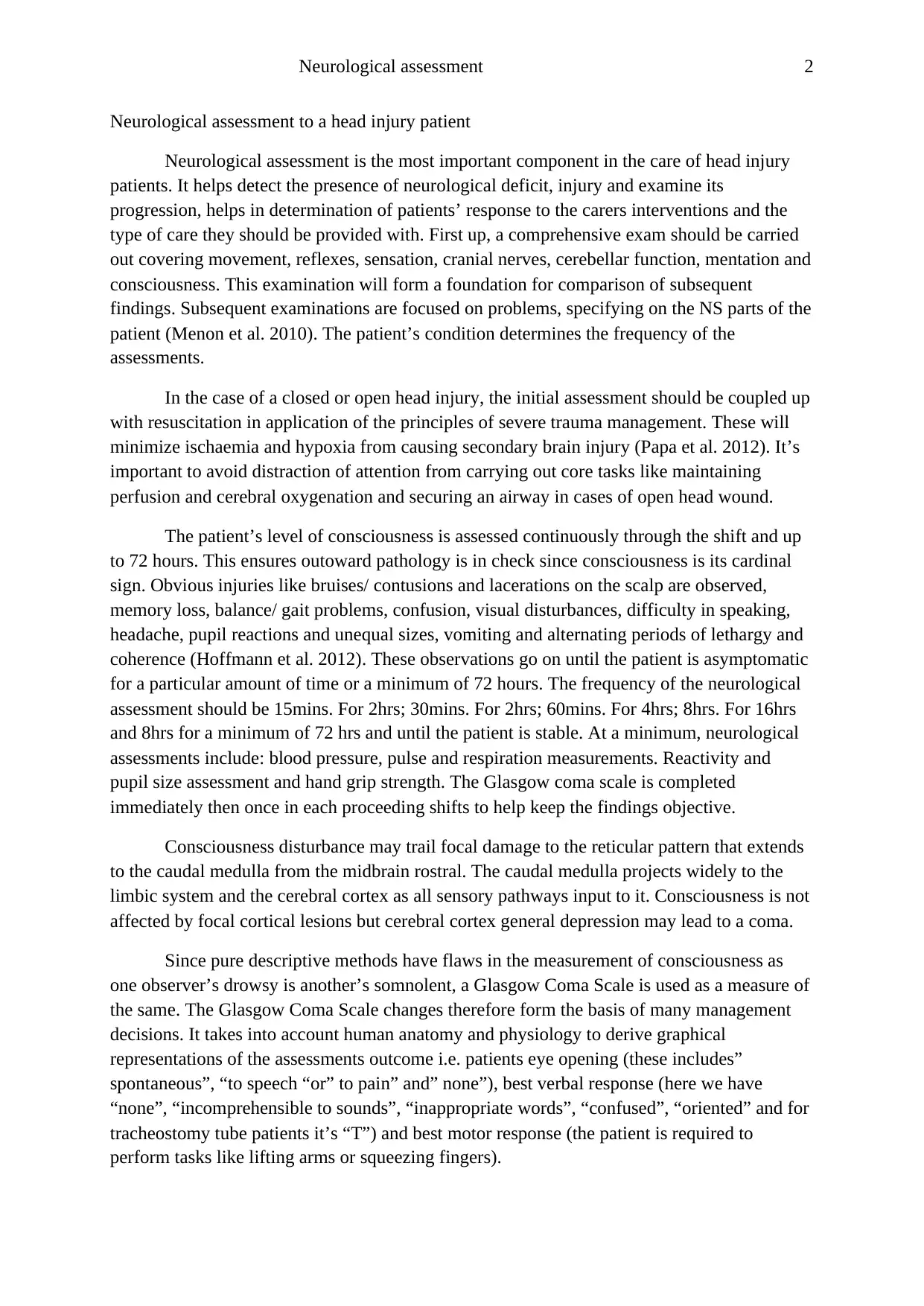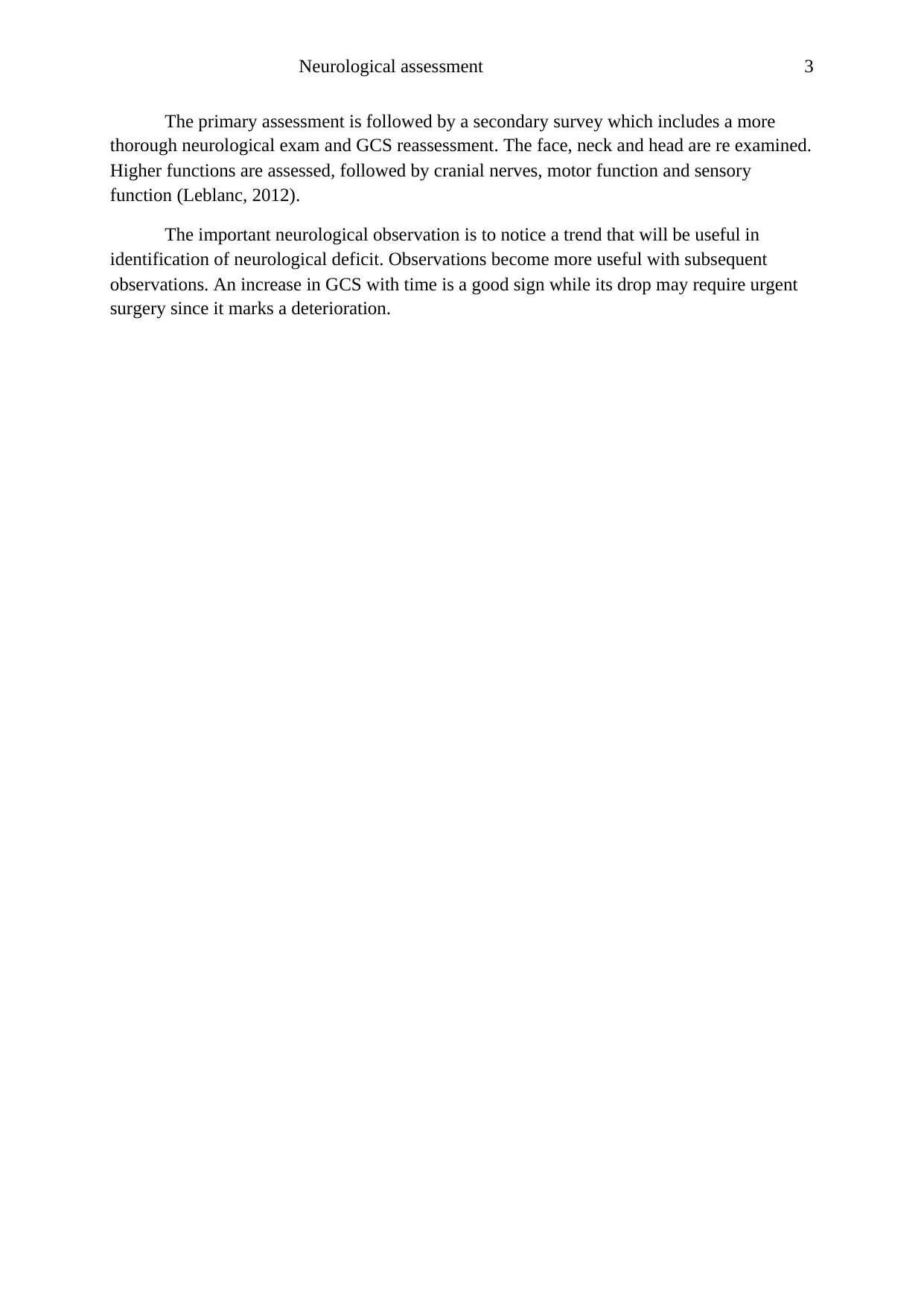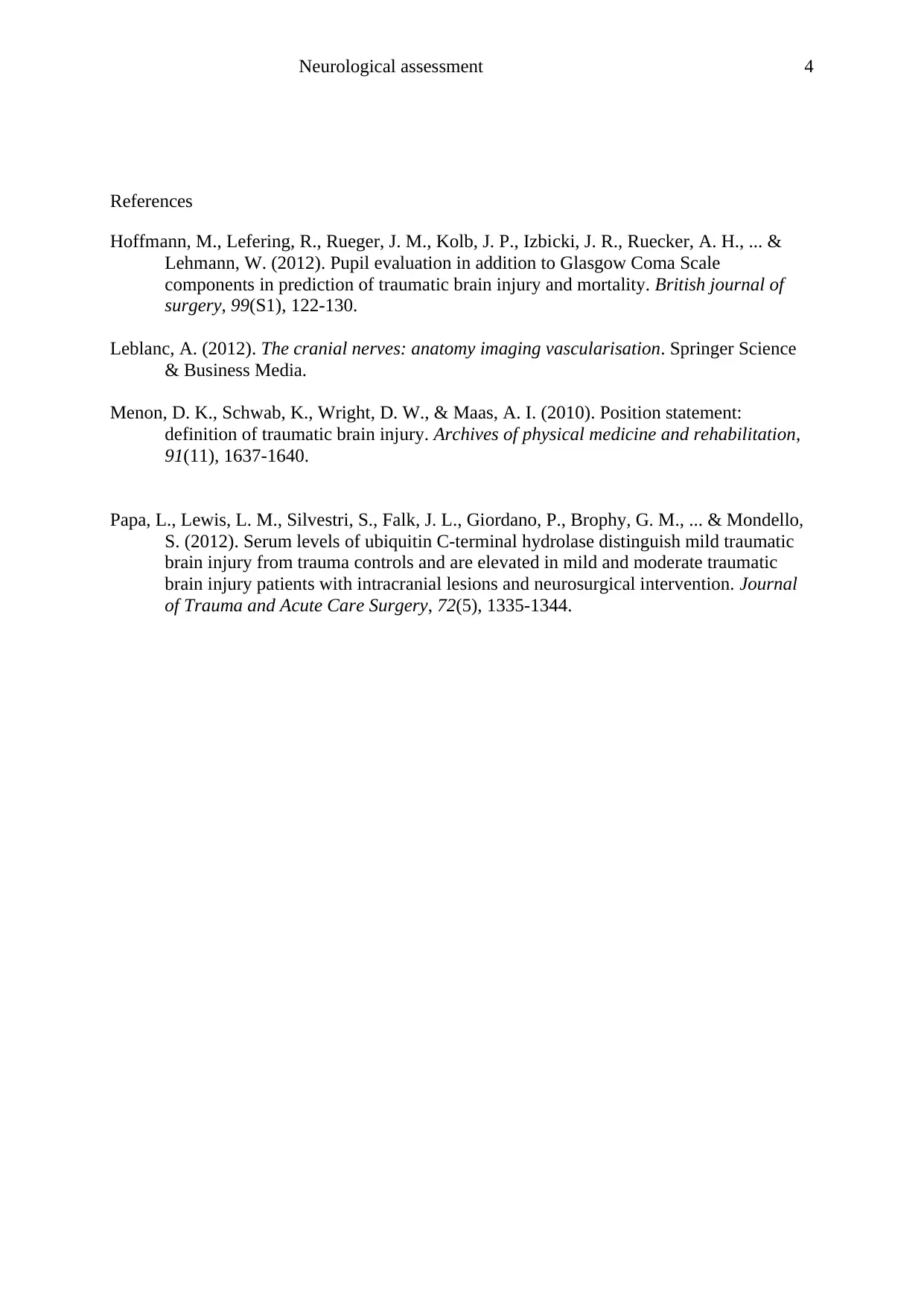Neurological Assessment of Head Injury Patients
VerifiedAdded on 2020/04/01
|4
|954
|132
AI Summary
This assignment delves into the crucial role of neurological assessment in managing head injury patients. It outlines a comprehensive assessment process encompassing movement, reflexes, sensation, cranial nerves, cerebellar function, mentation, and consciousness. The document emphasizes the importance of continuous monitoring, using the Glasgow Coma Scale to track patient condition, and identifying trends in neurological status. Specific guidelines for frequency of assessments and key observations are provided, highlighting the significance of timely interventions based on assessment findings.
Contribute Materials
Your contribution can guide someone’s learning journey. Share your
documents today.

Neurological assesment
Name
Title
University Affiliation
Name
Title
University Affiliation
Secure Best Marks with AI Grader
Need help grading? Try our AI Grader for instant feedback on your assignments.

Neurological assessment 2
Neurological assessment to a head injury patient
Neurological assessment is the most important component in the care of head injury
patients. It helps detect the presence of neurological deficit, injury and examine its
progression, helps in determination of patients’ response to the carers interventions and the
type of care they should be provided with. First up, a comprehensive exam should be carried
out covering movement, reflexes, sensation, cranial nerves, cerebellar function, mentation and
consciousness. This examination will form a foundation for comparison of subsequent
findings. Subsequent examinations are focused on problems, specifying on the NS parts of the
patient (Menon et al. 2010). The patient’s condition determines the frequency of the
assessments.
In the case of a closed or open head injury, the initial assessment should be coupled up
with resuscitation in application of the principles of severe trauma management. These will
minimize ischaemia and hypoxia from causing secondary brain injury (Papa et al. 2012). It’s
important to avoid distraction of attention from carrying out core tasks like maintaining
perfusion and cerebral oxygenation and securing an airway in cases of open head wound.
The patient’s level of consciousness is assessed continuously through the shift and up
to 72 hours. This ensures outoward pathology is in check since consciousness is its cardinal
sign. Obvious injuries like bruises/ contusions and lacerations on the scalp are observed,
memory loss, balance/ gait problems, confusion, visual disturbances, difficulty in speaking,
headache, pupil reactions and unequal sizes, vomiting and alternating periods of lethargy and
coherence (Hoffmann et al. 2012). These observations go on until the patient is asymptomatic
for a particular amount of time or a minimum of 72 hours. The frequency of the neurological
assessment should be 15mins. For 2hrs; 30mins. For 2hrs; 60mins. For 4hrs; 8hrs. For 16hrs
and 8hrs for a minimum of 72 hrs and until the patient is stable. At a minimum, neurological
assessments include: blood pressure, pulse and respiration measurements. Reactivity and
pupil size assessment and hand grip strength. The Glasgow coma scale is completed
immediately then once in each proceeding shifts to help keep the findings objective.
Consciousness disturbance may trail focal damage to the reticular pattern that extends
to the caudal medulla from the midbrain rostral. The caudal medulla projects widely to the
limbic system and the cerebral cortex as all sensory pathways input to it. Consciousness is not
affected by focal cortical lesions but cerebral cortex general depression may lead to a coma.
Since pure descriptive methods have flaws in the measurement of consciousness as
one observer’s drowsy is another’s somnolent, a Glasgow Coma Scale is used as a measure of
the same. The Glasgow Coma Scale changes therefore form the basis of many management
decisions. It takes into account human anatomy and physiology to derive graphical
representations of the assessments outcome i.e. patients eye opening (these includes”
spontaneous”, “to speech “or” to pain” and” none”), best verbal response (here we have
“none”, “incomprehensible to sounds”, “inappropriate words”, “confused”, “oriented” and for
tracheostomy tube patients it’s “T”) and best motor response (the patient is required to
perform tasks like lifting arms or squeezing fingers).
Neurological assessment to a head injury patient
Neurological assessment is the most important component in the care of head injury
patients. It helps detect the presence of neurological deficit, injury and examine its
progression, helps in determination of patients’ response to the carers interventions and the
type of care they should be provided with. First up, a comprehensive exam should be carried
out covering movement, reflexes, sensation, cranial nerves, cerebellar function, mentation and
consciousness. This examination will form a foundation for comparison of subsequent
findings. Subsequent examinations are focused on problems, specifying on the NS parts of the
patient (Menon et al. 2010). The patient’s condition determines the frequency of the
assessments.
In the case of a closed or open head injury, the initial assessment should be coupled up
with resuscitation in application of the principles of severe trauma management. These will
minimize ischaemia and hypoxia from causing secondary brain injury (Papa et al. 2012). It’s
important to avoid distraction of attention from carrying out core tasks like maintaining
perfusion and cerebral oxygenation and securing an airway in cases of open head wound.
The patient’s level of consciousness is assessed continuously through the shift and up
to 72 hours. This ensures outoward pathology is in check since consciousness is its cardinal
sign. Obvious injuries like bruises/ contusions and lacerations on the scalp are observed,
memory loss, balance/ gait problems, confusion, visual disturbances, difficulty in speaking,
headache, pupil reactions and unequal sizes, vomiting and alternating periods of lethargy and
coherence (Hoffmann et al. 2012). These observations go on until the patient is asymptomatic
for a particular amount of time or a minimum of 72 hours. The frequency of the neurological
assessment should be 15mins. For 2hrs; 30mins. For 2hrs; 60mins. For 4hrs; 8hrs. For 16hrs
and 8hrs for a minimum of 72 hrs and until the patient is stable. At a minimum, neurological
assessments include: blood pressure, pulse and respiration measurements. Reactivity and
pupil size assessment and hand grip strength. The Glasgow coma scale is completed
immediately then once in each proceeding shifts to help keep the findings objective.
Consciousness disturbance may trail focal damage to the reticular pattern that extends
to the caudal medulla from the midbrain rostral. The caudal medulla projects widely to the
limbic system and the cerebral cortex as all sensory pathways input to it. Consciousness is not
affected by focal cortical lesions but cerebral cortex general depression may lead to a coma.
Since pure descriptive methods have flaws in the measurement of consciousness as
one observer’s drowsy is another’s somnolent, a Glasgow Coma Scale is used as a measure of
the same. The Glasgow Coma Scale changes therefore form the basis of many management
decisions. It takes into account human anatomy and physiology to derive graphical
representations of the assessments outcome i.e. patients eye opening (these includes”
spontaneous”, “to speech “or” to pain” and” none”), best verbal response (here we have
“none”, “incomprehensible to sounds”, “inappropriate words”, “confused”, “oriented” and for
tracheostomy tube patients it’s “T”) and best motor response (the patient is required to
perform tasks like lifting arms or squeezing fingers).

Neurological assessment 3
The primary assessment is followed by a secondary survey which includes a more
thorough neurological exam and GCS reassessment. The face, neck and head are re examined.
Higher functions are assessed, followed by cranial nerves, motor function and sensory
function (Leblanc, 2012).
The important neurological observation is to notice a trend that will be useful in
identification of neurological deficit. Observations become more useful with subsequent
observations. An increase in GCS with time is a good sign while its drop may require urgent
surgery since it marks a deterioration.
The primary assessment is followed by a secondary survey which includes a more
thorough neurological exam and GCS reassessment. The face, neck and head are re examined.
Higher functions are assessed, followed by cranial nerves, motor function and sensory
function (Leblanc, 2012).
The important neurological observation is to notice a trend that will be useful in
identification of neurological deficit. Observations become more useful with subsequent
observations. An increase in GCS with time is a good sign while its drop may require urgent
surgery since it marks a deterioration.

Neurological assessment 4
References
Hoffmann, M., Lefering, R., Rueger, J. M., Kolb, J. P., Izbicki, J. R., Ruecker, A. H., ... &
Lehmann, W. (2012). Pupil evaluation in addition to Glasgow Coma Scale
components in prediction of traumatic brain injury and mortality. British journal of
surgery, 99(S1), 122-130.
Leblanc, A. (2012). The cranial nerves: anatomy imaging vascularisation. Springer Science
& Business Media.
Menon, D. K., Schwab, K., Wright, D. W., & Maas, A. I. (2010). Position statement:
definition of traumatic brain injury. Archives of physical medicine and rehabilitation,
91(11), 1637-1640.
Papa, L., Lewis, L. M., Silvestri, S., Falk, J. L., Giordano, P., Brophy, G. M., ... & Mondello,
S. (2012). Serum levels of ubiquitin C-terminal hydrolase distinguish mild traumatic
brain injury from trauma controls and are elevated in mild and moderate traumatic
brain injury patients with intracranial lesions and neurosurgical intervention. Journal
of Trauma and Acute Care Surgery, 72(5), 1335-1344.
References
Hoffmann, M., Lefering, R., Rueger, J. M., Kolb, J. P., Izbicki, J. R., Ruecker, A. H., ... &
Lehmann, W. (2012). Pupil evaluation in addition to Glasgow Coma Scale
components in prediction of traumatic brain injury and mortality. British journal of
surgery, 99(S1), 122-130.
Leblanc, A. (2012). The cranial nerves: anatomy imaging vascularisation. Springer Science
& Business Media.
Menon, D. K., Schwab, K., Wright, D. W., & Maas, A. I. (2010). Position statement:
definition of traumatic brain injury. Archives of physical medicine and rehabilitation,
91(11), 1637-1640.
Papa, L., Lewis, L. M., Silvestri, S., Falk, J. L., Giordano, P., Brophy, G. M., ... & Mondello,
S. (2012). Serum levels of ubiquitin C-terminal hydrolase distinguish mild traumatic
brain injury from trauma controls and are elevated in mild and moderate traumatic
brain injury patients with intracranial lesions and neurosurgical intervention. Journal
of Trauma and Acute Care Surgery, 72(5), 1335-1344.
1 out of 4
Your All-in-One AI-Powered Toolkit for Academic Success.
+13062052269
info@desklib.com
Available 24*7 on WhatsApp / Email
![[object Object]](/_next/static/media/star-bottom.7253800d.svg)
Unlock your academic potential
© 2024 | Zucol Services PVT LTD | All rights reserved.